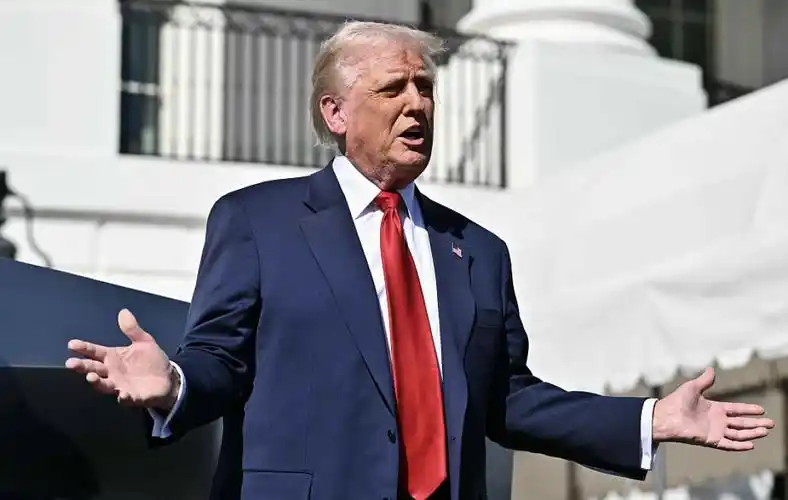US President Donald Trump announced the imposition of the highest US tariffs in a century, intensifying efforts to reshape the global economy and unsettling investors who believe that a trade war poses risks to US economic growth.
Trump announced on Wednesday that he would impose at least a 10% tariff on all goods exported to the United States and higher tariffs on approximately 60 countries to offset the huge trade imbalance with the United States. This includes some of the United States’ largest trading partners, such as China (where tariffs on many goods are already far higher than 50%), as well as the European Union, Japan and Vietnam.
At the so-called reciprocal tariff unveiling ceremony held in the White House Rose Garden, Trump said, “For many years, other countries have become rich and powerful, and a large part of that has been at our expense, while hardworking American citizens have been forced to stand by and watch. Now it’s our turn to thrive.”
This move marks a sharp escalation of Trump’s trade war, which may trigger immediate retaliation from other countries and upend the calculations of domestic businesses and consumers.
The president has used tariffs as a tool to maintain US power, revitalize domestic manufacturing and force geopolitical concessions, which runs counter to the decades-long consensus that lowering trade barriers helps promote ties among nations and prevent conflicts. Economists say the short-term result of his measures could be rising prices and slower economic growth in the US, and could even lead to a recession.
After Trump announced the decision, U.S. stock index futures plunged by more than 3% in after-hours trading, and oil prices also dropped sharply. The Chinese stock market fell, the RMB depreciated, and the key index measuring mainland stocks listed in Hong Kong opened down 2.6%, but later recovered some ground.
Less than three months after returning to the White House, Trump has erected trade barriers that, in some respects, are even more severe than the notorious trade protectionism of the 1930s. Bloomberg Economics estimates that the actual tax rate the US currently imposes on more than $3 trillion worth of imported goods could rise to around 23%, higher than at any time in more than a century.
The reciprocal tariffs announced on Wednesday were based on the US government’s assessment of various barriers and taxes imposed by other countries on US goods.
Trump said the United States would only charge half of that rate, but it is not yet clear exactly how it will be calculated. The 10% benchmark rate on all importing countries will take effect after midnight on Saturday. The White House said higher tariffs on targeted countries will take effect on April 9 and will replace rather than add to the 10% rate.
At present, the new measures do not cover Canada and Mexico, as there are intermittent tariff disputes between these two countries and the United States. The new measures also do not apply to some products subject to separate tariffs under the so-called Section 232 investigation, such as automobiles, semiconductors and wood.
Mary Lovely, a senior fellow at the Peterson Institute for International Economics, said that reciprocal tariffs “are much more serious than we feared.” She added that this would “have a huge impact on the rerouting of trade.”
The president sought to frame his trade plan as an incentive for blue-collar voters, speaking in the Rose Garden with union members and workers from various industries, including a retired auto worker who spoke on stage. Then, Trump spent 48 minutes of his speech waving large signs to show the new tax rates for each country.
China is the United States’ biggest economic rival and was the main target of Trump’s trade war during his first term. Now, China has once again become the target of Trump’s attacks.
According to White House documents, China will face a reciprocal tariff rate of 34%, while Trump has already imposed a 20% tariff on fentanyl trafficking this year. This means that many Chinese imported products will face tariffs far higher than 50%. According to estimates by Bloomberg Economics, this tariff is sufficient to destroy most of the Sino-US trade by the end of this century.
Trump also announced that he would end the duty-free transportation of small packages from China under the so-called minimum exemption system.
The Ministry of Commerce of China made its first official response, stating that it will take countermeasures, but did not specify what measures China might take. The Ministry of Commerce called on the United States to “immediately cancel unilateral tariff measures and properly resolve differences with trading partners through equal dialogue.”
Other major Asian exporters are also under pressure. The tariff reciprocity rates for the United States’ close allies, Japan and South Korea, are around 20%, while Vietnam, one of the United States’ fastest-growing trading partners, has a tariff reciprocity rate that is nearly twice that of the United States.
Wendy Cutler of the Asia Society Policy Institute said, “Asian countries in particular seem to be at risk.”
The EU is preparing to take emergency measures to protect its economy from the impact of Trump’s tariffs, but the country still has to pay a 20% tariff.
Trump is taking a historic gamble, the risks of which include a global trade war marked by tit-for-tat strikes, disruption of supply chain stability and damage to US exporters. After the president announced the decision, the treasury secretary urged other countries not to retaliate.
Trump said that if trading partners take measures to boost US exports, he would consider lowering tariff rates. He urged foreign leaders to “cancel their own tariffs, remove barriers” and “not manipulate currencies”.
The president declared a national emergency tied to the scale of the trade deficit, a move that enables him to use special powers to impose tariffs. The government aims to generate hundreds of billions of dollars in revenue through new taxes to help fill the government coffers before pushing for tax cuts.
Trump and his trade advisers believe that tariffs will encourage businesses to move their manufacturing operations to the United States, rebuild the country’s industrial base and create jobs. In the meantime, they implore the public to be patient, saying that any short-term economic pain is worth it for reshaping the economy.
This dynamic could become a political problem for Trump. Any benefits from the economic restructuring in the US may take years or even longer to materialize. But many economists warn that the pain from tariffs could come quickly in the form of higher prices.
With consumer confidence already shaken, this may be hard for Americans worried about inflation to accept – and inflation was one of the key issues that helped Trump into the White House.
Olu Sonola, the head of US economic research at Fitch Ratings, said: “This is a turning point not only for the US economy but also for the global economy. Many countries may eventually fall into recession. If this tariff rate persists for some time, most predictions will fall through.”


